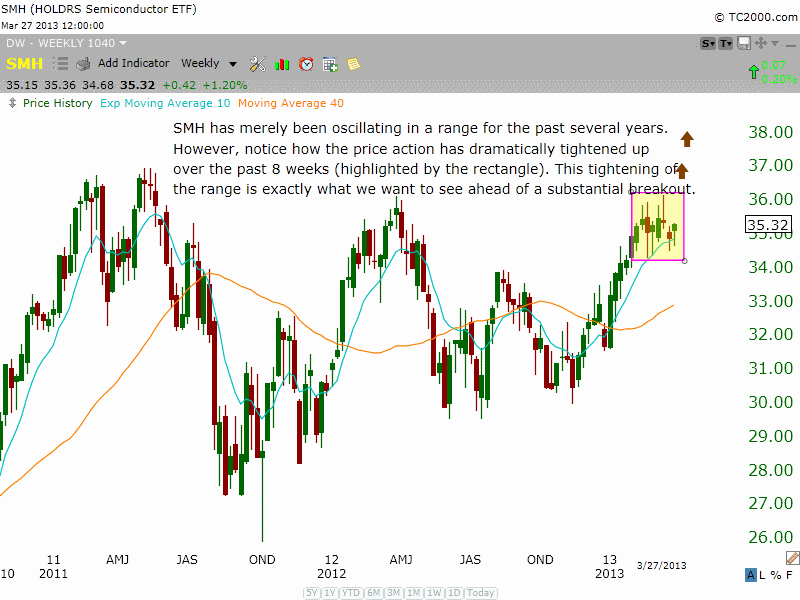Throughout the entire rally of 2013, the Nasdaq has been lagging behind, while the Dow and other large-cap stocks have been showing leadership. Over the past week, however, we have been spotting what may be early signs of institutional sector rotation out of the Dow and into the Nasdaq. Within the Nasdaq, one industry sector that appears poised to make a substantial intermediate-term move to the upside is semiconductors.
Yesterday, we already highlighted a nice breakout setup in MagnaChip Semiconductor Corp. (MX), an individual stock within the semiconductor industry. However, we also like the bullish action we are seeing in Market Vectors Semiconductor ETF (SMH), a popular ETF proxy for the semiconductor sector.
For starters, take a look at the long-term monthly chart of SMH below:
Many swing traders focus primarily on the daily chart interval, while ignoring longer-term charts such as the monthly. This is a mistake because it prevents traders from seeing the “big picture” of what is really happening within specific industry sectors.
In the case of SMH, we see that the ETF has just broken out above resistance of a downtrend that has been in place since 2004. But this major trend reversal above a very long-term resistance level would not be apparent without looking at the monthly chart time frame.
Obviously, the monthly chart interval is NOT used for determining specific entry and exit points for actual swing trade setups. When one bar equals an entire month of price action, determining where to buy or sell based on that chart would be impossible for short-term traders. As such, when we identify something we like on a longer-term chart, such as this SMH pattern, we then drill down to the shorter-term weekly and daily chart intervals.
The weekly chart of SMH is shown below:
Notice that SMH has been oscillating in a wide range since late 2010. However, the price action has tightened up dramatically over the past eight weeks. Combined with the breakout above the nine-year downtrend line, this price consolidation and base building is bullish. Furthermore, notice that the 10-week moving average (teal line) is acting as support AND has pulled away from the 40-week moving average, which is now sloping higher as well. These are all bullish signals that typically precede big “stealth” breakouts that the average retail trader will not see until it becomes quite obvious.
Although we pointed out the head and shoulders pattern of PowerShares Nasdaq 100 Index (QQQ) in this March 24 post, recall we said the bearish pattern was only valid for short selling entry IF QQQ fell below both its 50-day MA and prior swing low. If that does not happen, and QQQ manages to breakout above its recent highs instead (the high of its right shoulder), the pattern will become a failed head and shoulders.
When a head and shoulders pattern fails, the breakout to the upside is usually explosive because the bears who were betting on a move lower become forced to cover their short positions. For now, we see no reason to sit in cash with the market in a clear uptrend and new setups emerging in leadership stocks. We must always trade what we see, not what we think!
Original post
- English (UK)
- English (India)
- English (Canada)
- English (Australia)
- English (South Africa)
- English (Philippines)
- English (Nigeria)
- Deutsch
- Español (España)
- Español (México)
- Français
- Italiano
- Nederlands
- Português (Portugal)
- Polski
- Português (Brasil)
- Русский
- Türkçe
- العربية
- Ελληνικά
- Svenska
- Suomi
- עברית
- 日本語
- 한국어
- 简体中文
- 繁體中文
- Bahasa Indonesia
- Bahasa Melayu
- ไทย
- Tiếng Việt
- हिंदी
Why Semiconductors May Be The Next Sector To Blast Off
Published 03/28/2013, 07:35 AM
Updated 07/09/2023, 06:31 AM
Why Semiconductors May Be The Next Sector To Blast Off
3rd party Ad. Not an offer or recommendation by Investing.com. See disclosure here or
remove ads
.
Latest comments
Install Our App
Risk Disclosure: Trading in financial instruments and/or cryptocurrencies involves high risks including the risk of losing some, or all, of your investment amount, and may not be suitable for all investors. Prices of cryptocurrencies are extremely volatile and may be affected by external factors such as financial, regulatory or political events. Trading on margin increases the financial risks.
Before deciding to trade in financial instrument or cryptocurrencies you should be fully informed of the risks and costs associated with trading the financial markets, carefully consider your investment objectives, level of experience, and risk appetite, and seek professional advice where needed.
Fusion Media would like to remind you that the data contained in this website is not necessarily real-time nor accurate. The data and prices on the website are not necessarily provided by any market or exchange, but may be provided by market makers, and so prices may not be accurate and may differ from the actual price at any given market, meaning prices are indicative and not appropriate for trading purposes. Fusion Media and any provider of the data contained in this website will not accept liability for any loss or damage as a result of your trading, or your reliance on the information contained within this website.
It is prohibited to use, store, reproduce, display, modify, transmit or distribute the data contained in this website without the explicit prior written permission of Fusion Media and/or the data provider. All intellectual property rights are reserved by the providers and/or the exchange providing the data contained in this website.
Fusion Media may be compensated by the advertisers that appear on the website, based on your interaction with the advertisements or advertisers.
Before deciding to trade in financial instrument or cryptocurrencies you should be fully informed of the risks and costs associated with trading the financial markets, carefully consider your investment objectives, level of experience, and risk appetite, and seek professional advice where needed.
Fusion Media would like to remind you that the data contained in this website is not necessarily real-time nor accurate. The data and prices on the website are not necessarily provided by any market or exchange, but may be provided by market makers, and so prices may not be accurate and may differ from the actual price at any given market, meaning prices are indicative and not appropriate for trading purposes. Fusion Media and any provider of the data contained in this website will not accept liability for any loss or damage as a result of your trading, or your reliance on the information contained within this website.
It is prohibited to use, store, reproduce, display, modify, transmit or distribute the data contained in this website without the explicit prior written permission of Fusion Media and/or the data provider. All intellectual property rights are reserved by the providers and/or the exchange providing the data contained in this website.
Fusion Media may be compensated by the advertisers that appear on the website, based on your interaction with the advertisements or advertisers.
© 2007-2024 - Fusion Media Limited. All Rights Reserved.
